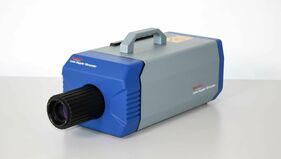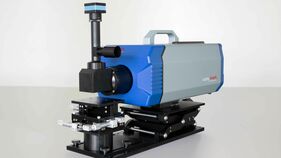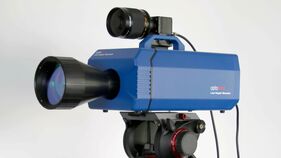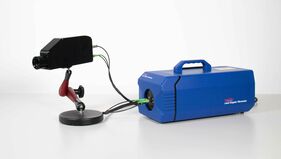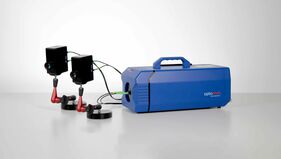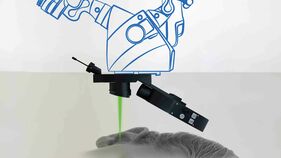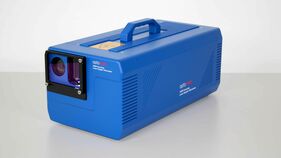
Vector Series
Digital Free Beam HeNe Laser Vibrometer: Precise vibration measurements without the price tag.
Traditional laser Doppler vibrometers (LDV) with helium-neon (HeNe) laser sources have been a useful tool for non-contact vibration measurement for many years. Optomet has perfected HeNe based laser vibrometry with the Vector series. The Vector series with a laser wavelength of 633 nm enables the non-contact vibration measurements of objects of microscopic to macroscopic sizes with the highest accuracy and precision.
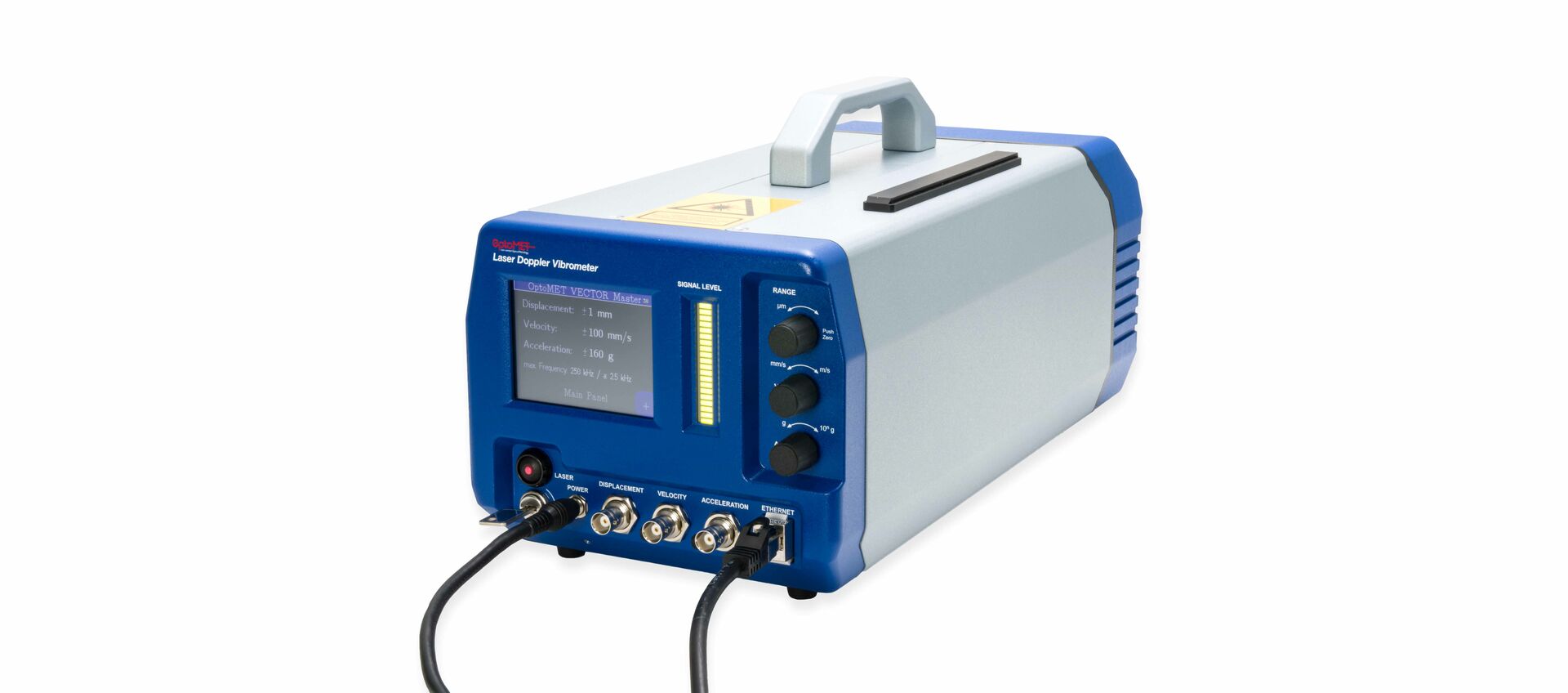
High flexibility for a variety of applications
The Vector series is the standard vibrometer for a wide range of vibration measurement problems. It is particularly suitable for surfaces with high to moderate surface reflectivity, for measurements on or below the surface of water and for applications in which the smallest laser spot size is critical.

Water is not an obstacle
Helium-Neon lasers have a wavelength of 633 nm and are able to shine through water with minimal loss of laser power. HeNe vibrometers are therefore indispensable if there is a layer of water between the vibrometer and the vibrating measurement object.
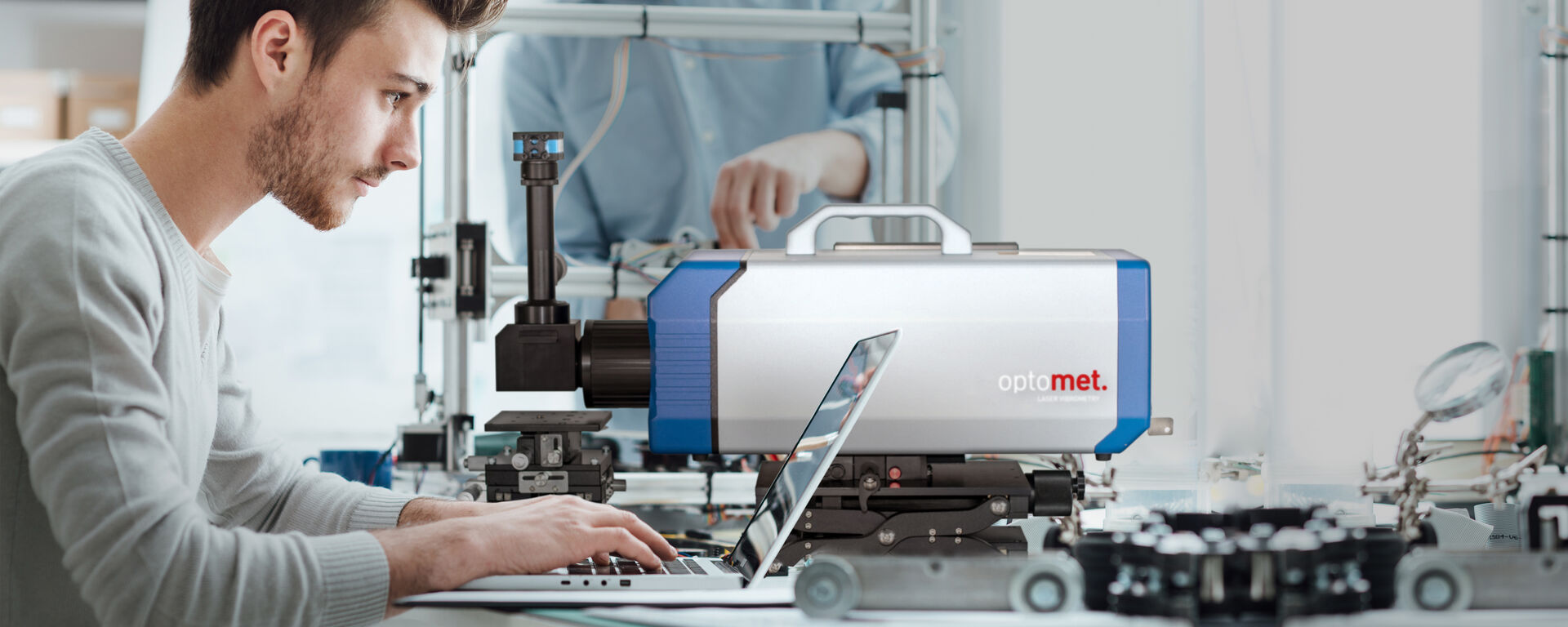
Measuring Microstructures
Due to their short wavelength, HeNe lasers allow the measurement beam to be optimally focused on the order of micrometers. They are therefore the ideal choice for measurements of the smallest features or microstructures.
Highlights
• Non-contact vibration measurement up to 25 MHz
• End-to-end digital workflow
• 14 velocity-, 19 displacement- und 14 acceleration measuring ranges
• Vibrational velocities up to ±10 m/s
• Displacement resolutions down to 100 fm
• Decoder remote update and upgradeable
• 3 analogue output with a sample rate of 160 Msamples/s
• GBit-Ethernet digital output
• Visible, eye-safe class 2 laser
• Compact and portable All-in-One design
• Intuitive handling
• High power efficiency
Possible application
High frequency vibration measurement
Laser vibrometer measuring and data acquisition software
OptoGUI
OptoGUI is an extensive and intuitive software for remote control, data acquisition, and data analysis when working in single-point mode. Data transfer is realized via a loss-free digital Gigabit Ethernet connection.
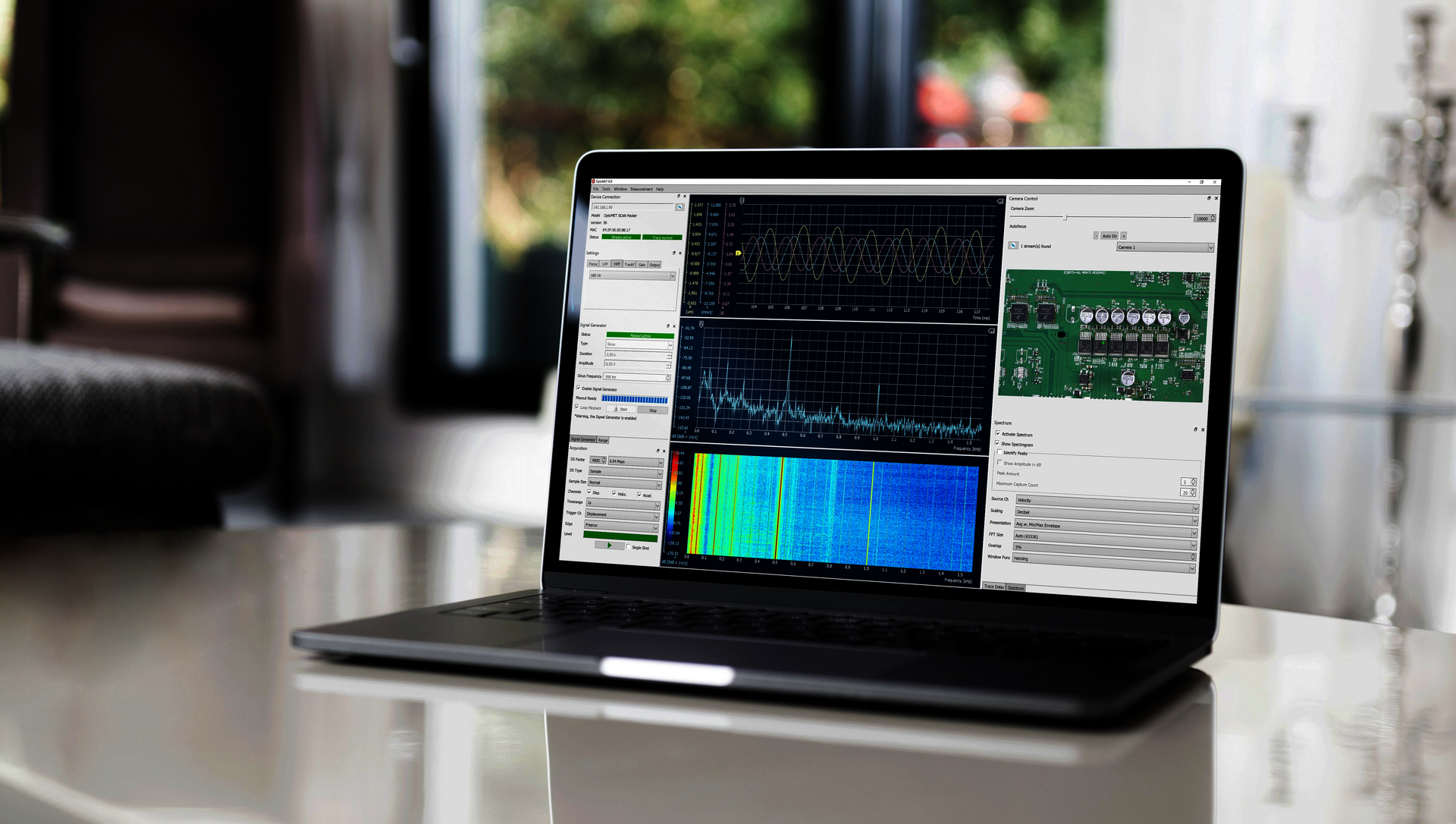
Specifications
A detailed list of all vibrometer characteristics, including all hardware and software features, can be found in the vibrometer data sheet in Support & Datasheets.
| Category | Characteristics |
|---|---|
| Laser source | HeNe-Laser |
| Laser wavelength | 632,8 nm |
| Laser class | Output power: <1 mW, class 2 |
| Measured quantity | Velocity, Displacement, Acceleration |
| Frequency bandwidths | DC to 25 MHz |
| Max. vibrational velocity | 10 m/s |
| Output signal (digital) | GBit-Ethernet (RJ45) / WiFi |
| Output signal (analog) | 3 x Standard BNC connectors |
| Signal processing | Digital (Optomet UltraDSP) |
| User interface output | Color screen 3.5" + 20 segment LED bargraph |
| User interface input | Touch screen, knobs with push-button, key switch (power) |
| Dimensions | Length x width x height (excluding handle and lens): 380 x 180 x 148 mm |
| Weight | 8 kg |
| Mounting | Standard tripod screw thread |
| Power supply | 110 -240V AC (50-60Hz) oder 12V DC |
| Power consumption | 37 Watt |
| Operating temperature range | 0°C to 40°C |
Available Decoders
A wide variety of high-performance real-time decoders are available for the evaluation of the interferometric measuring signals. The Optomet UltraDSP technology enables the measurement of frequencies up to 25 MHz and vibrational velocities up to 10 m/s with the Vector Series, displacements can be resolved to less than 100 fm. All vibrometers incorporate a velocity decoder, and displacement and acceleration decoders are optionally available. Numerous measuring ranges per decoder ensure that measurements can always be performed with the optimum sensitivity.
Decoders can be easily retrofitted or upgraded. Start with a basic system and adapt the capabilities of the measuring instrument as required. This requires no return of the instrument to the factory and no waiting times for your production or research project. The table below provides an overview of the configuration options. We will also be happy to assist you in the selection of the best decoder for your measuring task.
Start
| Decoder Name | Number of measuring ranges | Max. vibrational velocity | Frequency | Comments |
|---|---|---|---|---|
| Velocity Decoder D-VD-0 | 8 | 2 m/s | DC - 100 kHz | required |
| Displacement Decoder D-DD-0 | 19 |
| optional | |
| Acceleration Decoder D-AD-0 | 8 |
| optional |
Basis
| Decoder Name | Number of measuring ranges | Max. vibrational velocity | Frequency | Comments |
|---|---|---|---|---|
| Velocity Decoder D-VD-1 | 8 | 2 m/s | DC - 500 kHz | required |
| Displacement Decoder D-DD-1 | 19 |
| optional | |
| Acceleration Decoder D-AD-1 | 8 |
| optional |
Sense
| Decoder Name | Number of measuring ranges | Max. vibrational velocity | Frequency | Comments |
|---|---|---|---|---|
| Velocity Decoder D-VD-2 | 11 | 2 m/s | DC - 1 MHz | required |
| Displacement Decoder D-DD-2 | 19 |
| optional | |
| Acceleration Decoder D-AD-2 | 11 |
| optional |
Sense-Remote
| Decoder Name | Number of measuring ranges | Max. vibrational velocity | Frequency | Comments |
|---|---|---|---|---|
| Velocity Decoder D-VD-2-R | 11 | 2 m/s | DC - 25 kHz | required |
| Displacement Decoder D-DD-2-R | 19 |
| optional | |
| Acceleration Decoder D-AD-2-R | 11 |
| optional |
High Speed
| Decoder Name | Number of measuring ranges | Max. vibrational velocity | Frequency | Comments |
|---|---|---|---|---|
| Velocity Decoder D-VD-3 | 11 | 10 m/s | DC - 2,5 MHz | required |
| Displacement Decoder D-DD-3 | 19 |
| optional | |
| Acceleration Decoder D-AD-3 | 11 |
| optional |
High Frequency
| Decoder Name | Number of measuring ranges | Max. vibrational velocity | Frequency | Comments |
|---|---|---|---|---|
| Velocity Decoder D-VD-4 | 9 | 5 m/s | DC - 10 MHz | required |
| Displacement Decoder D-DD-4 | 19 |
| optional | |
| Acceleration Decoder D-AD-4 | 9 |
| optional |
Master
| Decoder Name | Number of measuring ranges | Max. vibrational velocity | Frequency | Comments |
|---|---|---|---|---|
| Velocity Decoder D-VD-5 | 14 | 10 m/s | DC- 10 MHz | required |
| Displacement Decoder D-DD-5 | 19 |
| optional | |
| Acceleration Decoder D-AD-5 | 14 |
| optional |
Master+
| Decoder Name | Number of measuring ranges | Max. vibrational velocity | Frequency | Comments |
|---|---|---|---|---|
| Velocity Decoder D-VD-5-25 | 14 | 10 m/s | DC - 25 MHz | required |
| Displacement Decoder D-DD-5-25 | 19 |
| optional | |
| Acceleration Decoder D-AD-5-25 | 14 |
| optional |
Available lenses
Several lenses are available which are optimized for the Nova-Series. Choose the right optical system based on working distance, reflectivity of the surface to be measured or size of the focus point. The lenses are easily exchangeable due to a bayonet lock as on single-lens reflex cameras.
The table below provides an overview of the configuration options. We will also be happy to assist you in the selection of the best lens for your measuring task.

Short-Range Interchangeable lens
• Working distance: 0 mm ... 5 m
• Autofocus, remote focus, manual focus
• Focus spot size (typ.): 6 µm at 8 mm

Mid-Range Interchangeable lens
• Working distance: 95 mm ... 10 m
• Autofocus, remote focus, manual focus
• Focus spot size (typ.): 10 µm at 95 mm

Long-Range Interchangeable lens
• Working distance: 500 mm ... 100 m
• Autofocus, remote focus, manual focus
• Focus spot size (typ.): 30 µm at 500 mm

Super-Long-Range Interchangeable lens
• Working distance: 2100 mm ... 200 m
• Autofocus, remote focus, manual focus
• Focus spot size (typ.): 126 µm at 2100 mm
Accessories

Single Point Vibrometer Transport Case
Stable and waterproof Peli case for safe keeping and transport of vibrometer.
External dimension (L x B x H): 61.9 x 49.2 x 22.3 cm
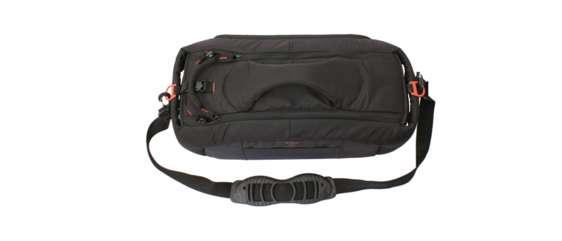
Transport Bag
Compact und light transport bag for the outdoors-measurements

Tripod with Fluid Head
Precisely align your vibrometer with high quality tripods by Manfrotto.

 SMART Scan+
SMART Scan+
 SMART 3D-Scan
SMART 3D-Scan
 SMART Full Body
SMART Full Body
 SMART Single+
SMART Single+
 SMART Multi-Fiber
SMART Multi-Fiber
 SMART 3D-Fiber
SMART 3D-Fiber
 SMART DAQ
SMART DAQ
 Software SMART Lab
Software SMART Lab
 Scanning Vibrometer
Scanning Vibrometer
 Vector-Series
Vector-Series
 Vector-Micro-Optics
Vector-Micro-Optics
 Nova-Series
Nova-Series
 Nova-Xtra
Nova-Xtra
 Fiber-Series
Fiber-Series
 Fiber-Multiplex
Fiber-Multiplex
 Fiber Micro Manipulator
Fiber Micro Manipulator
 OptoSCAN
OptoSCAN
 OptoGUI
OptoGUI
 Acoustics & Ultrasonics
Acoustics & Ultrasonics
 Aerospace and aviation
Aerospace and aviation
 Automotive
Automotive
 Biology & Medicine
Biology & Medicine
 Brake noise
Brake noise
 Civil Engineering
Civil Engineering
 Electronics & Household Devices
Electronics & Household Devices
 Materials Research
Materials Research
 Medical technology
Medical technology
 Tools & Machinery
Tools & Machinery
 Turbine
Turbine
 Wind tunnel testing
Wind tunnel testing

